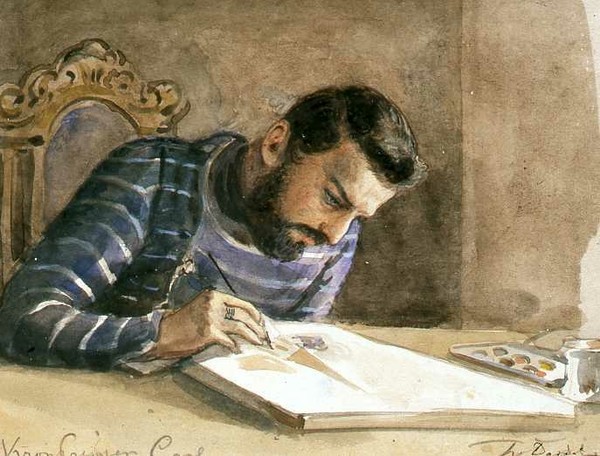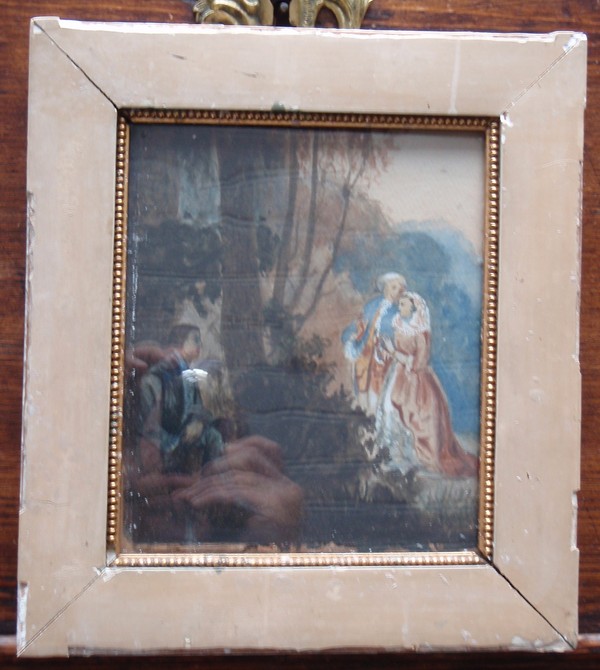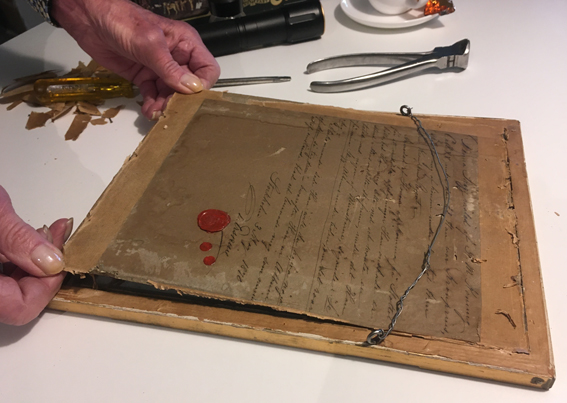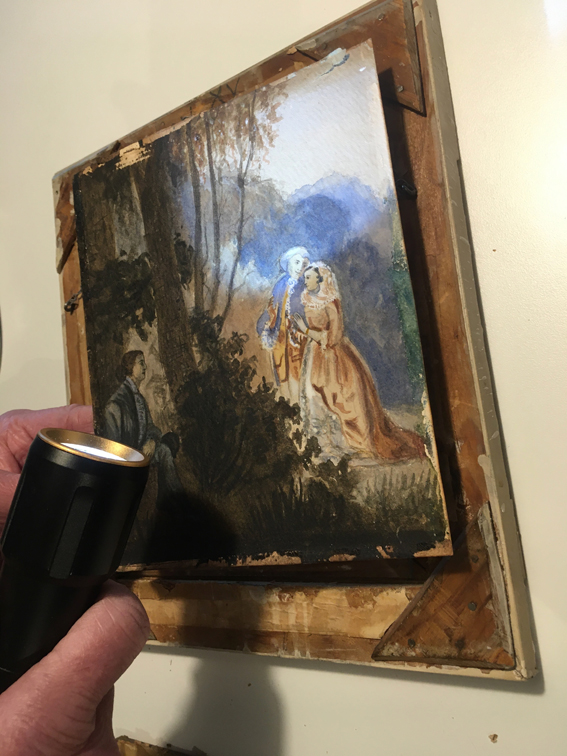Slumpen förde original och skiss till samma par ögon? Karl XV-målnings äkthet bestyrkt!

Kronprins Karl, den blivande Karl XV, hade den Bernadotteska konstnärliga ådran och var en flitig konstnär. Akvarell av Fritz von Dardel 1849. Nordiska museets föremål inv.nr 67453.
I mitt barndomshem hängde en liten oansenlig akvarell i Pappas rum eller alldeles utanför ibland. Den föreställde ett promenerande par i skogsmiljö. Till synes 1700-tal med mannen i vit peruk och kvinnan i krinolin. I skuggan av träden finns det som gör bilden intressant! Där sitter en man och synes hålla paret under uppsikt. Mannens roll i bilden skapar undran. Vem är han? En försmådd älskare? Kyskhetskontrollant?
Tavlan var osignerad men sades vara målad av Kung Karl XV och på tavlans kartongbaksida hade någon också ristat in "Målning af Carl XV".
Ja, ja, tänkte man väl. Någon större tilltro till uppgifterna satte man kanske inte. Det har funnits så många förhoppningsfulla i tillvaron som velat göra någonting värdefullare än det var.
 Barndomshemmets lilla akvarell.
Barndomshemmets lilla akvarell.
Ja, ja, tänkte man väl. Någon större tilltro till uppgifterna satte man kanske inte. Det har funnits så många förhoppningsfulla i tillvaron som velat göra någonting värdefullare än det var.

Men så en dag för något år sedan dyker det upp en målning på Uppsala Auktionskammare som jag råkar få syn på på nätet. Är det inte samma målning?

Jag läser vidare i katalogtexten:
Karl XV 1826-1872. Par i landskap och en sittande man. Akvarell och täckvitt på papper, 19,5 x 13,5 cm.
Med påskrift på bakstycke: "Denna Skizz målad af H.M Konung Carl XV, under den tid Han var
Kronprins, skänkts mig af honom under den tid Han var Kronprins-Regent. Anmodad af Honom
uppkomma på Slottet för att meddela upplysningar Han önskade erhålla, bad Han mig sitta ned och
vänta en stund i Hans enskilta skrifrum, under det Han talade med någon af Ministrarne, sägande: 'Se på mina Skizz-albums under tiden, om det roar dig'. Återkommande sade Han: 'will du hafva någon af dem, så tag den' - hwarefter Han ur Album utref omstående blad och lemnade mig som minne.
Stockholm 3 May 1870 D. Erskine". Samt med Erskines lacksigill.
Karl XV 1826-1872. Par i landskap och en sittande man. Akvarell och täckvitt på papper, 19,5 x 13,5 cm.
Med påskrift på bakstycke: "Denna Skizz målad af H.M Konung Carl XV, under den tid Han var
Kronprins, skänkts mig af honom under den tid Han var Kronprins-Regent. Anmodad af Honom
uppkomma på Slottet för att meddela upplysningar Han önskade erhålla, bad Han mig sitta ned och
vänta en stund i Hans enskilta skrifrum, under det Han talade med någon af Ministrarne, sägande: 'Se på mina Skizz-albums under tiden, om det roar dig'. Återkommande sade Han: 'will du hafva någon af dem, så tag den' - hwarefter Han ur Album utref omstående blad och lemnade mig som minne.
Stockholm 3 May 1870 D. Erskine". Samt med Erskines lacksigill.
Fantastiskt! Att det är en skiss till den lilla akvarellen som jag har efter föräldrarna syns ju rätt tydligt. Figurerna är mer skissartat framställda, färger och linjer enklare. Men med berättelsen på baksidan måste jag ju bara köpa in tavlan. Den utgör ju faktiskt samtidigt ett äkthetsintyg för föräldrarnas målning.
Sagt och gjort. Den lilla akvarellskissen ropades in och så småningom tog jag med mig båda till min vän papperskonservatorn Helen Skinner som öppnade båda ramarna och tog ut innehållet vilket var mycket spännande. Skulle det stå något på baksidorna av själva målningarna.

Här öppnar Helen försiktigt akvarellskissen med det klistrade intyget på kartongens baksida.

Och här undersöker hon skadorna på originalakvarellen. Det visar sig att det gamla glaset från tiden var mindre än ramen och dessutom var kantskärningen amatörmässig vilket gett sylvassa spetsar och kanter på glaset som när det glidit runt i den större ramen gett skador utmed kanterna på akvarellen som syns på bilden. På baksidan står "Teckning af Carl XV osign."
Helen gav mig sedan en fullständig statusrapport för de båda bilderna med förslag på vilka åtgärder hon ansåg att man skulle göra. Och hon fick naturligtvis uppdraget.
Efter en månad kunde jag hämta ut resultatet. Efter genomgång vid hennes matbord där jag fick se det lösgjorda intyget och den lagade originalakvarellen (skissen hade inte behövt några åtgärder), så förpackade hon med minutiös noggrannhet, bilderna, Erskines intyg, ramarna, de gamla bakstyckena och glasskivorna var för sig och varje del märkt med "1" eller "2" beroende till vilken bild det hörde.
Nu ska det hela lämnas till rammakare som får se till att allt blir snyggt och prydligt ramat. Jag hör ju till dem som ogärna byter ut gammalt glas på gamla bilder, men i det här fallet måste den lilla originalakvarellen få ett nytt glas om är anpassat efter ramen så att inga nya skador uppstår. Ramarna rengörs och fixas till i glappande hörn. stödkartongen byts ut mot syrafritt alternativ. I skissens ram ska vi försöka att också lägga Erskines intyg på baksidan med en egen glasskiva så att man kan se intyget men att det sitter skyddat och framförallt inte klistrat på bakstycket som tidigare, med skador som följd. Papperet är oerhört skört.
Är inte detta ett fantastiskt spratt av Slumpen! Att just jag som äger originalet som säkert funnits i vår familj i hundra år skulle få syn på den utbjudna skissen och kunna koppla ihop de båda verken och även ropa in den och låta dem återförenas!

Originalakvarellen restaurerad. Men fortfarande kvarstår frågan: Vad gör karl'n bland buskarna?